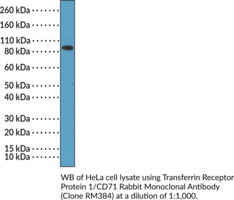Territorial Availability: Available through Bertin Technologies only in France
- Correlated keywords
- extra cellular ecto domain antiTfR1
- Product Overview:
Transferrin receptor protein 1 (TfR1), also known as CD71, is a homodimeric transmembrane receptor for transferrin (Item No. 32030) that facilitates iron delivery into cells and is encoded by TFRC in human.{46988} It is composed of two TfR1 monomers, each composed of a 67-amino acid cytoplasmic tail with an internalization motif, a membrane spanning portion, a stalk region that covalently links the monomers, and an extracellular ectodomain. The ectodomain binds transferrin and is composed of an apical domain, a protease-like domain, and a helical domain that drives TfR1 dimerization.{46988,55229} TfR1 is ubiquitously expressed, except on mature red blood cells and certain terminally differentiated cells, with the highest expression on immature erythroid cells and in the placenta, and is involved in erythropoiesis, lymphocyte development, and hematopoietic expansion in the bone marrow.{54708,54709} TfR1/transferrin-mediated iron transport contributes to the intracellular iron pool required for ferroptosis and anti-TfR1 antibodies have been used in combination with anti-malondialdehyde antibodies to identify ferroptotic cells in vitro and human cancer tissue in a mouse xenograft model.{46994} A soluble form of TfR1 is present in serum and increased levels are associated with autoimmune hemolytic anemia, polycythemia vera, and iron deficiency anemia, while decreased levels are associated with chronic renal failure and aplastic anemia.{54710} TFRC is overexpressed in various breast cancer tumors and gliomas and positively correlated with poor prognosis.{46992} Cayman’s TfR1/CD71 Rabbit Monoclonal Antibody can be used for immunohistochemistry (IHC) and Western blot (WB) applications.
Cayman Chemical’s mission is to help make research possible by supplying scientists worldwide with the basic research tools necessary for advancing human and animal health. Our utmost commitment to healthcare researchers is to offer the highest quality products with an affordable pricing policy.
Our scientists are experts in the synthesis, purification, and characterization of biochemicals ranging from small drug-like heterocycles to complex biolipids, fatty acids, and many others. We are also highly skilled in all aspects of assay and antibody development, protein expression, crystallization, and structure determination.
Over the past thirty years, Cayman developed a deep knowledge base in lipid biochemistry, including research involving the arachidonic acid cascade, inositol phosphates, and cannabinoids. This knowledge enabled the production of reagents of exceptional quality for cancer, oxidative injury, epigenetics, neuroscience, inflammation, metabolism, and many additional lines of research.
Our organic and analytical chemists specialize in the rapid development of manufacturing processes and analytical methods to carry out clinical and commercial GMP-API production. Pre-clinical drug discovery efforts are currently underway in the areas of bone restoration and repair, muscular dystrophy, oncology, and inflammation. A separate group of Ph.D.-level scientists are dedicated to offering Hit-to-Lead Discovery and Profiling Services for epigenetic targets. Our knowledgeable chemists can be contracted to perform complete sample analysis for analytes measured by the majority of our assays. We also offer a wide range of analytical services using LC-MS/MS, HPLC, GC, and many other techniques.
Accreditations
ISO/IEC 17025:2005
ISO Guide 34:2009
Cayman is a leader in the field of emerging drugs of abuse, providing high-purity Schedule I-V Controlled Substances to federally-licensed laboratories and qualified academic research institutions for forensic analyses. We are certified by ACLASS Accreditation Services with dual accreditation to ISO/IEC 17025:2005 and ISO Guide 34:2009.





